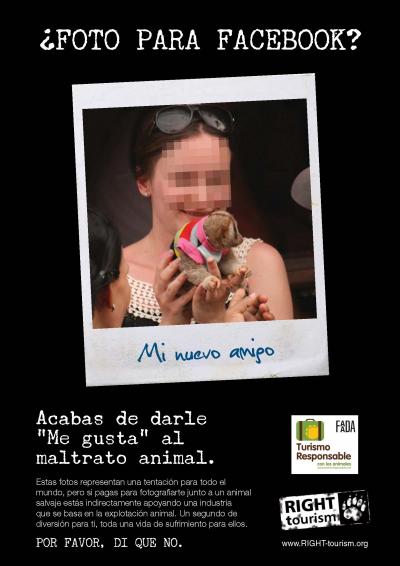Interaction - Photos with Animals

In many situations, and attracted by the direct contact with an exotic animal, tourists pay to take pictures with a wild animal, especially big cats cubs or primates, but also with parrots, alligators, snakes and others. What they may not know is that these animals are often taken from their mothers at an early age and that constant handling and contact with humans are extremely stressful to them.
We list some of the reasons why you should not support the use of animals for photographs:
- Activities like these can have very negative effects on the conservation of the species because most animals used are poached from the wild where populations are being reduced. For a baby gibbon, for example, may have had to kill his entire family.
- Pups are separated from their mothers after birth –with the emotional distress and frustration of their instincts that this implies- with the intention to make them "imprint" with humans rather than with other members of their species.
- To avoid personal injury, these animals may be given tranquilizers, have their claws and teeth removed, their mouths may be sealed or s they may be chained. (See more information below)
- Animals may be forced to spend the whole day and even night in bar and nightclub areas, passing from hand to hand and private rest needed for growth and health.
- Under these conditions, animals cannot carry out their most basic behaviors or those dictated by their instinct
- Animals used for this purpose may be only weeks old - when they are very delicate. Only in 2010, 23 tiger cubs from a big cat breeder in the U.S. who uses animals for this purpose, died.
- Once they have become too large or aggressive, they are often replaced and may end up abandoned in appalling conditions, illegally smuggled (or parts thereof) or killed. In Asia, as cubs grow up they can be sold for their parts for 'traditional medicine'.
- Out of the tourists’ sight, animals used to generate income from these activities, often live in appalling conditions: chained, and often in small cages without veterinary care or an appropriate diet.
- Some animals can transmit diseases to humans and vice versa. Three quarters of all emerging infectious threats are zoonotic.
- Sometimes animal owners claim to carry out an animal protection or conservation project and that the money they make will help other animals in need. However, a real conservation center would not breed their animals or exploit for money.
- Activities such as these promote the keeping of exotic and wild animals as pets - which involves serious animal welfare, safety, smuggling and abandonment problems.
Declawing and Sedation
To facilitate handling and reduce the risk of interactions between big cats and people, a common practice is to declaw the animals.
Far from being an unharmful procedure, it is a brutal and painful process that has broad implications for the animals.
Claws are removed by cutting the animal's entire third phalanx of every finger up to the joint; so bones, nerves, joint capsules, ligaments and tendons are also cut off.
- After surgery, the animals often suffer excruciating pain, damage to the radial nerve and profuse bleeding, bone fragments may remain inside hindering healing or claws can regrow inside of the feet.
- The loss of this part of the finger changes the conformation of the animals’ feet which can cause damage to the pads and abnormalities in their mobility as they must step on the ground at an unnatural angle, which usually causes back pain.
- Declawed animals can also suffer chronic pain in the back and joints as the muscles of their shoulders, legs and sword weaken.
- After losing their claws, these animals have difficulty gripping the meat to eat.
- The removal of the claws may even affect the personality of the animals, either making them more apathetic or more nervous, skittish and therefore aggressive. Some try then to defend themselves with their fangs (which is also common to pull out or sand down)
Many of the declawed big cats that have been rescued have needed complex surgeries to try to correct some of these problems.
To avoid attacks on people, it is also common to sedate animals before any interaction. So it is not so obvious that the animal has been tranquilized, and to pose for photographs with tourists, sometimes they are sprayed water on the face or are provoked with pieces of meat. In places like the infamous Tiger Temple in Thailand, they are sprayed with urine from other dominating tigers in an attempt to keep them submissive.
